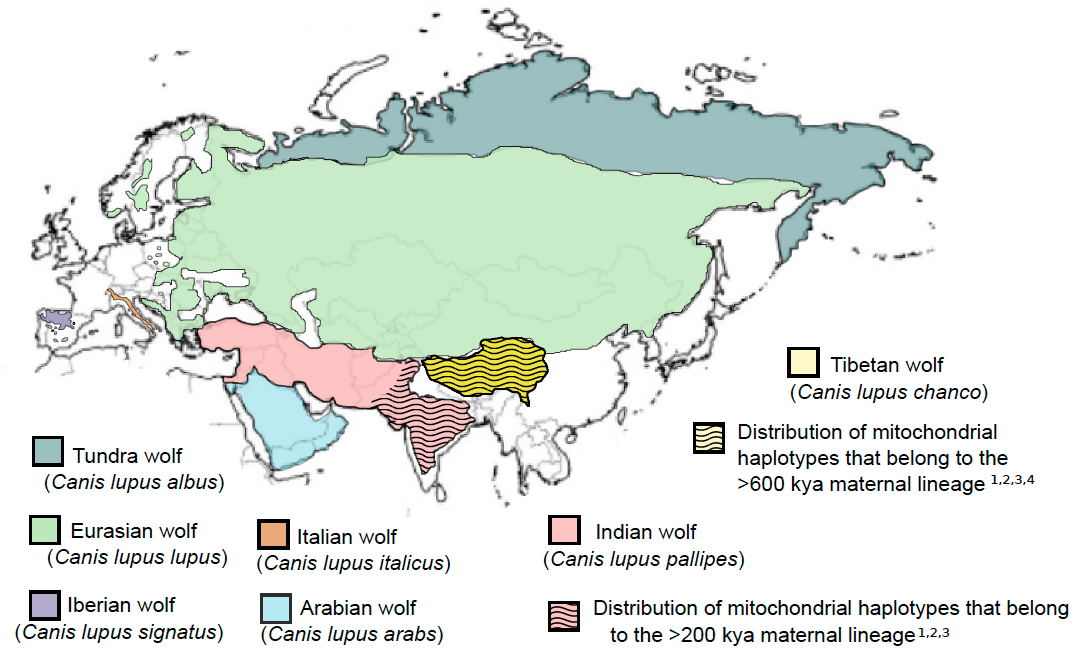My research revolves around understanding the evolutionary processes that shape genomic diversity of species and between their populations. For this, I use genomic tools, computational methods, and collaborate with a wide range of researchers to answer questions on the evolution and ecology of species, focused on mammals. I am deeply interested in ensuring that the scientific knowledge generated from this research is applied to conservation.
POSTDOCTORAL RESEARCH - LOCAL ADAPTATION IN GRAY WOLVES
My postdoctoral research investigates the ecological and evolutionary processes that underlie local adaptation in a wild mammal, the gray wolf. This research is multidisplinary and combines genomic technologies, ecological/environmental data, and phenotypic measures to investigate mechanisms that generate and facilitate local adaptation in gray wolves.
PhD RESEARCH: GRAY WOLVES OF SOUTH AND CENTRAL ASIA
My Ph.D research used whole genome data to study the evolutionary history of gray wolves in Eurasia. For this research, I used various field-based, genomic, and computational methods as well as collaborate with a wide range of researchers to answer questions on gray wolves. A strong component of this research was focused on gray wolves in South Asia and involved collaboration with various governmental organizations, universities, and NGOs in India and Pakistan. With newly sequenced gray wolf genomes generated from my Ph.D work, I investigated patterns of divergence, demographic history, and gene flow across wolf populations in Asia.

Figure 1. Distribution and taxonomy of gray wolves in Eurasia. The distribution of each currently recognized gray wolf subspecies in Eurasia (Castello 2018, Alvarez et al. 2019). Wavy lines indicate the distribution of evolutionarily distinct populations within the Indian wolf (Canis lupus pallipes) and Tibetan wolf (Canis lupus chanco) based on mitochondrial analyses (1Sharma et al. 2004, 2Aggarwal et al. 2007, 3Esrmark et al. 2016, 4Werhahn et al. 2020).
GENOMES, PHYLOGENETICS AND HYBRIDIZATION
Genealogical relationships among recently diverged lineages are often complex, involving discordance among different regions of the genome. Disentangling signals of the historical branching pattern, gene flow between lineages, and stochastic assorting of ancestral alleles of recently diverged lineages is particularly challenging. For understanding gray wolf evolutionary history, I have utilized various statistical methods to help characterize the evolution of recently diverged, yet interfertile lineages. This has involved leveraging our understanding of how phylogeny and gene flow leave distinct signatures on genomes, as well as how their distribution is influenced by recombination, to investigate historical relationships among gray wolves. This research work has been published in Molecular Ecology.

Figure 2. Topology weights for three possible topologies of Indian, Tibetan, and Holarctic lineages with Dhole as an outgroup across the X chromosome.
DYNAMICS OF GENE FLOW AND SELECTION AT CONTACT ZONES IN PAKISTAN
More broadly, gray wolves in Asia provide a system to study the processes influencing whether and how lineage boundaries between highly mobile, yet genomically distinct populations are maintained. Based on preliminary and published mitochondrial data, the appearance of a relatively sharp contact zone between Tibetan, Indian, and Holarctic lineages is located in Pakistan and northern India. Whether these mitochondrial boundaries align with abrupt nuclear genomic boundaries or if widespread gene flow is occurring between wolf lineages across this mitochondrial contact zone is unknown. Additionally, it is unknown whether some adaptive genes may have been introgressed between deeply divergent wolf lineages and canid species, which may have allowed Holarctic gray wolves to expand to nearly every habitat type in the last ~30,000 years.
Over the last four years, I’ve been working with collaborators from NGOs and universities in Pakistan to understand wolf distribution and evolutionary history. This information will help us answer both evolutionary questions on how genomically distinct lineages maintain their distinctiveness as well as conservation questions related to gray wolves. Gray wolves are especially rare and endangered in Pakistan, and this research will provide key information for delineating populations for conservation effort. Additionally, Pakistan is centered within prominent contact zones for other mammal species, and this study will yield fundamental insights into processes that have shaped regional species diversity at this biogeographic junction of West, South, and Central Asia.

Figure 3. Lineage distribution of the three main lineages of gray wolves.